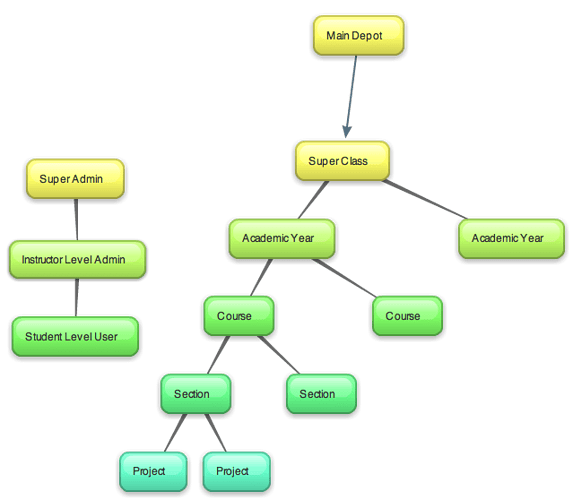While this week wasn’t that production heavy in content creation I was able to get some more of the conceptual side nailed down in terms of general structure and where this is headed. So sort of a re-group, breather week.
To just start from the top, I reorganized the the structure of both my RTest_Depot and R_Assets Depot. UncCheezy had a good point in the Admin folder being at the top of my main depot that contains the scripts for admins to run. So it now looks like:
//RTest_Depot/SuperClass
//RTest_Depot/Admin
//RTest_Depot/Admin/Scripts
//RTest_Depot/Admin/Projects
//RTest_Depot/Admin/Users
This way all utility scripts for the admin are contained in the Scripts folder. The Projects folder will contain a list of current active Projects in the tree and the Users folder will contain a list of the Users assigned to the tree. This is to just give a comprehensible list of everything to the Admin easily.
The R_Assets Depot was also reworked in a similar way where I removed the Admin directory from there and added a few more Libraries, those being for Shaders and Animation. I also ended up splitting the Models into two sub directories of FBX and OBJ format.
The biggest change in this Depot though was to the Texture Library since that is what I am trying to get up and running next. These directories now contain a subfolder that contains thumbnails of all the images in the specific folder. My thoughts for this being so that when the Image Library browser tool is brought up, instead of generating thumbnails on the fly for the visual navigation, it will just draw from the specific folder. example:
//R_Assets/Libraries/Textures/Wood
//R_Assets/Libraries/Textures/Wood/Thumbnails
//R_Assets/Libraries/Textures/Metal
//R_Assets/Libraries/Textures/Metal/Thumbnails
Along with all these slight changes I’ve also been writing a few simple utility scripts for the admin and have started the layout for the Texture browser. These being:
groupRevoke - This script removes all groups from the projects at the end of a semester, mostly for cleanup since the groups would no longer be needed.
p4pc_point.txt - A simple text document to auto populate some fields in the p4projectcreation tool. Automatically selects the current year and semester.
userProfiles - Updates the users list in the admin folder, Ill eventually add the Projects list into this tool
thumbnailer - Creates thumbnails of all textures in the texture library and saves them to the Thumbnail folder of the respective type. Im hoping to eventually make this a job on the server so that when new textures are uploaded they automatically have a thumbnail created to be used.
More functionality has also been added to the p4projectcreation tool, it now creates subfolders within the new project of all the users that are given permission, less setup the User and Admin would have to do overall.
This upcoming week is when things start to get fun again. As I mentioned earlier in the post I’ll be writing and hopefully have a working copy of the texture library browser up and running in a bare bones form. In conjunction with this ill be looking into some XML and finding a nice open source model viewer that we can use for the models library. This doesn’t seem too hard, just finding one that fits our needs.
I have also just received some of the scripts we’d like to start adding to the depot to be checked out, so I’ll be sorting those out into the respective sub-catagories (Texturing,Modeling,Lighting,Animating) and testing that system out! Overall just working on the scripts to refine them. In addition to this I will also be looking into a way to implement P4 in the Maya environment and coming up with a way for that. Jeremy Ernst had a nice setup of this so I might be modeling it after his.
The next step after this which I had some time to contemplate about is the creation of our social sites and documentation (Tutorials, script documenting) we will also be using but I’ll save that for next time when I have something more concrete laid out.
Sorry for the lack of pretty pictures this time haha :laugh: and thank you again to those that read!







